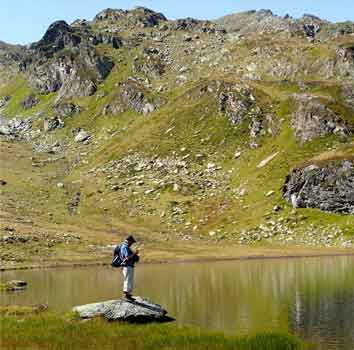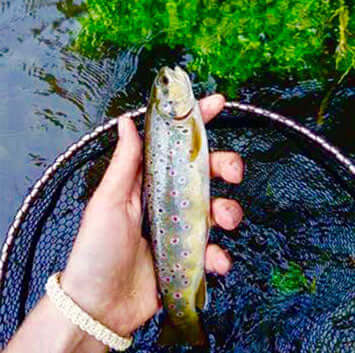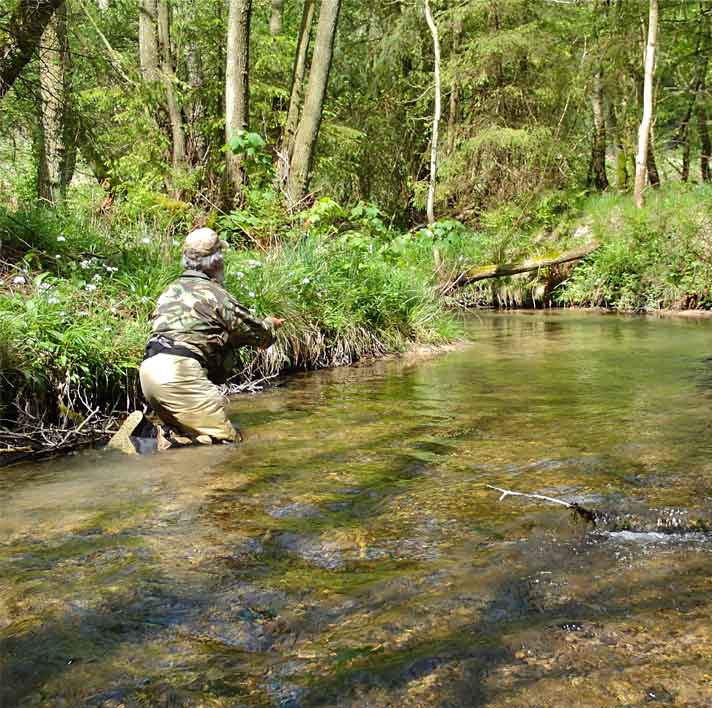At the time of writing (early July 2018) much of the UK has had over two months of dry weather. The spate rivers are desperately low & we are reaching a point where Salmonids on some rivers & many of the shallower lowland lakes are becoming stressed due to high water temperatures & low dissolved oxygen levels. The low oxygen levels on many rivers are not just a direct result of the decreased solubility of this vital gas as water temperatures rise but also a reflection of the increased BOD (Biological Oxygen Demand, the demand for oxygen by the organisms in the water). This increased BOD is brought about by the increased metabolic rate of cold-blooded organisms as their temperature rises, plus eutrophication (enrichment with nitrates & phosphates) & organic pollution, the sources of which include sewage outfalls, agricultural sources & fish farms. As a result trout, grayling & salmon become lethargic & may even die. We fly fishers need to be aware of how to cope with such conditions.
Most importantly if we intend catch & release fishing we need to consider fish-welfare. Prolonged playing of fish in water that is low in dissolved oxygen will seriously stress the fish, possibly leading to a serious, even lethal, buildup of lactic acid in their muscles (lactic acid is a product of anaerobic respiration, a process that releases energy without the need for oxygen). Lactic acid is highly toxic & can only be removed if there is an adequate supply of oxygen for it to be broken down (this is known as an Oxygen Debt & is the reason sprinters fight for breath after they have completed a race). It is therefore essential to play fish to the net quickly. Ideally use a floating net such as that devised by Glen Pointon so that the netted fish can be left in the water whilst being unhooked. It can also be left to recover in the net rather than being immediately released which can result in the fish turning belly up if it has not been fully revived. Alternatively the fish should be held gently with its mouth pointing into a good flow of water. On no account should the fish be subjected to prolonged exposure to air whilst photos are being taken. If you have to take photos then the camera should be setup before hand & ideally the fish should be still in the water whilst being photographed.
Fish welfare can also be ensured by fishing on waters where the water temperature & oxygen levels do not reach critically low levels. Chalk streams & limestone spring creeks in their upper reaches are ideal as their water leaves the springs at 10 degrees C. On my local chalk stream, against all logic, the fish actively feed right through the brightest, hottest summer days & in bright sun sight-fishing is much easier to do as the fish are easily seen. High mountain streams & lakes are also less likely to overheat & are unlikely to be enriched by organic pollution. I am fortunate to live near the North Yorkshire Moors, which has several well-wooded streams & limestone spring creeks that do not suffer from overeating thanks to the tree-cover. Another alternative is to fish on rivers that receive cold compensation water from the bottom of reservoirs, what the Americans call ‘Tail Waters’.
Fishing in the low flows, gin-clear water & bright sun of summer can be very challenging. Furthermore fly hatches tend to be far less predictable than in spring & autumn. Early morning & late evening (even night time) can be the best times to fish, particularly if, like me, you prefer to fish the dry fly. Sedges, Caenis & Blue Winged Olives are more likely to be seen on the water at dusk, dawn & during darkness. Alternatively fish where there is a dense canopy of trees sheltering the water from the sun’s glare & the heat. On my local wooded spate rivers the fish are often active all day, feeding on tiny food items such as Midges, Aphids & Thunder Bugs/Thrips, so a size 24 CdC IOBO Humpy or Shuttlecock is generally required to achieve success. I should add that a sunny, hot day with a strong wind is perfect for fishing heavily wooded streams since the sun & heat make terrestrial insects more active & the wind will blow many of them onto the water; wood ants, beetles, caterpillars & aphids are all likely to be on the menu & a size 16 Black Foam Beetle can be an absolute ‘killer’.
To effectively fish tiny flies to spooky fish in low, clear, slow-flowing water requires extreme stealth both in the angler’s approach & his or her presentation of the fly, plus, of course, in most cases a drag-free drift & super accurate casting. My choice of tackle to cope with this scenario depends upon how large & open the river is. On tiny overgrown streams I’ll opt for a 6’ to 8’ 1 or 2 weight rod teamed up with a micro nymph line or 1 weight delicate presentation line such as the Sunray Jeremy Lucas micro thin line. I also like as long a leader & tippet as possible, generally 10’ to 15’ with tippets in the range 0.09mm to 0.12mm. On bigger, more open rivers my choice is a 10’ 2 weight rod such as the Sunray JL Volition, again teamed up with either a micro nymph line or Jeremy Lucas 1 weight & 10’ to 15’ leader, or for the ultimate in delicate presentation a 10’ 6”/ 11’ 6” Sunray Zero rod teamed up with either a micro nymph line or a greased 1x/10lb/0.25mm diameter fluorocarbon casting line plus 4’ of tippet.
If you have to fish open water on a spate river during the sun & heat of the day then it is logical to focus most of your attention on the fast riffles & pool heads where the turbulent flow is helping to oxygenate the water. In such situations a nymph or decent sized Elk Hair Caddis or Klinkhammer will generally give you the best chance of success.
So don’t let the challenges of summer heat & drought put you off fishing but do consider the fish’s welfare & adapt your tactics. There are of course several alternatives to fishing for Salmonids, carp are active surface feeders on hot, sunny days & a day on the beach fishing for bass, mullet or other sea fish could be a good choice.

Use a floating net & keep the fish in the water with no more than a second or two for a quick photo

Ensure the fish is fully recovered before it is released

Chalk stream grayling caught on 2nd July 2018 in the early afternoon of a baking hot day & returned safely

High mountain lakes stay cool even in the heat of a scorching summer
































